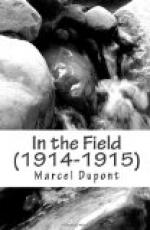I stopped my men for a moment. Surrounded by green meadows and stubble-fields dotted with apple-trees, lay the grey outskirts of the village It was a very ordinary collection of houses, some of them big farms, others humble cottages. The tiled roofs formed a reddish mass, and above them rose the squat church tower. With my glasses I could distinguish the clock-dial, and could see the time—a quarter past six.
But this clock seemed to be the only thing in the village with any life in it. I looked in vain into the gardens and orchards, which formed a belt of flowers and foliage, for signs of the peaceful animation of country life. And yet it was the time of day when one usually sees housewives coming out of the cowsheds, with their sleeves tucked up and their feet in clogs, carrying pails full of fresh milk—the time when the heavy carts and reaping machines lumber slowly along the brown roads on their way to the day’s work. Was it the war that had driven away all those poor village folk, or was it the rough fist of the Teuton that kept them prisoners locked up in their cellars and threatened with revolvers?
And yet, from where I stood, nothing could lead me to suppose that the village was occupied by the enemy. I could not distinguish any work of defence. There did not seem to be any barricade protecting the entrance. No sentinel was visible at the corners of the stacks or under the trees.
To the south of the village, pointing in our direction, the imposing bulk of a large farm protruded, like the prow of a ship. It seemed to form an advanced bastion of a fortress, represented by Courgivault. Its walls were high and white. At the end a strong round tower was planted, roofed with slates; and this enhanced the likeness to a miniature donjon. The road we had followed, winding between the fields, passed, so far as we could judge, in front of its principal entrance. Opposite this entrance there was apparently another road at right angles to the first, its direction marked by a line of trees which bordered it. Along this road, separated by short intervals, a dozen big stacks had the appearance of a threatening line of battle facing us, so as to bar our approach to the village.
All these things were steeped in the same atmosphere of silence, which certainly had a more tragic effect than the din of battle. I was impressed with the idea that the two armies had withdrawn in opposite directions, and that we were left behind, forgotten, at 100 kilometres distance from both of them.
But we had to come to the point. At a sign from me Vercherin reached the first tree of a long row of poplars. The row started from the farm and bordered the road we were following up to about 100 yards from the outer wall. By slipping along from one tree to another he would be able to get near in comparative safety. Suddenly I saw him stop quickly and, standing up in his stirrups, look straight ahead towards the stacks.




